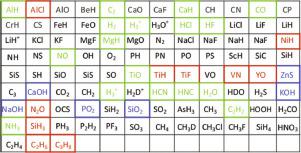Journal of Quantitative Spectroscopy and Radiative Transfer ( IF 2.3 ) Pub Date : 2020-07-24 , DOI: 10.1016/j.jqsrt.2020.107228 Jonathan Tennyson , Sergei N. Yurchenko , Ahmed F. Al-Refaie , Victoria H.J. Clark , Katy L. Chubb , Eamon K. Conway , Akhil Dewan , Maire N. Gorman , Christian Hill , A.E. Lynas-Gray , Thomas Mellor , Laura K. McKemmish , Alec Owens , Oleg L. Polyansky , Mikhail Semenov , Wilfrid Somogyi , Giovanna Tinetti , Apoorva Upadhyay , Ingo Waldmann , Yixin Wang , Samuel Wright , Olga P. Yurchenko

|
The ExoMol database (www.exomol.com) provides molecular data for spectroscopic studies of hot atmospheres. While the data are intended for studies of exoplanets and other astronomical bodies, the dataset is widely applicable. The basic form of the database is extensive line lists; these are supplemented with partition functions, state lifetimes, cooling functions, Landé g-factors, temperature-dependent cross sections, opacities, pressure broadening parameters, k-coefficients and dipoles. This paper presents the latest release of the database which has been expanded to consider 80 molecules and 190 isotopologues totaling over 700 billion transitions. While the spectroscopic data are concentrated at infrared and visible wavelengths, ultraviolet transitions are being increasingly considered in response to requests from observers. The core of the database comes from the ExoMol project which primarily uses theoretical methods, albeit usually fine-tuned to reproduce laboratory spectra, to generate very extensive line lists for studies of hot bodies. The data have recently been supplemented by line lists derived from direct laboratory observations, albeit usually with the use of ab initiotransition intensities. A major push in the new release is towards accurate characterisation of transition frequencies for use in high resolution studies of exoplanets and other bodies.
中文翻译:

2020年版的ExoMol数据库:系外行星和其他热大气的分子线列表
ExoMol数据库(www.exomol.com)提供了分子数据,用于热大气的光谱研究。尽管这些数据旨在用于研究系外行星和其他天文物体,但该数据集可广泛应用。数据库的基本形式是广泛的行列表。这些补充有分区功能,状态寿命,冷却功能,Landég因子,与温度有关的横截面,不透明度,压力扩展参数,k-系数和偶极子。本文介绍了该数据库的最新版本,该数据库已扩展为考虑80个分子和190个同位异位体,总计超过7,000亿个跃迁。尽管光谱数据集中在红外和可见光波长,但响应观察者的要求,人们越来越多地考虑使用紫外线跃迁。该数据库的核心来自ExoMol项目,该项目主要使用理论方法(尽管通常对其进行了微调以重现实验室光谱),以生成用于研究热体的非常广泛的线列表。最近通过直接实验室观察得到的线列表对数据进行了补充,尽管通常使用从头算起过渡强度。新版本的一个主要推动力是精确表征过渡频率,以用于系外行星和其他物体的高分辨率研究。











































 京公网安备 11010802027423号
京公网安备 11010802027423号